![]() 1st Battalion 22nd Infantry
1st Battalion 22nd Infantry ![]()
The 22nd Infantry 1874-1878
In July, 1874, the 22nd Infantry changed
stations with the First Infantry. Regimental Headquarters and
Companies D, F and H took station
at Fort Wayne, Michigan; Company A, at Madison Barracks, New
York; Companies B and K, at Fort Porter, New York;
C and G, Fort Brady; E, Fort Mackinac; I, Fort Gratiot, Michigan.
The advantages of garrison life and duties were not to last long,
however,
for on September 16, Companies A, B, D, F, H, I and K were
directed by telegraphic orders to proceed to New Orleans,
where an organization known as the White League had caused some
fear and concern as to the safety of that locality.
The Companies were packed and ready to start by midnight, and
took the train early on the morning of the 17th,
reaching New Orleans on the night of the 20th. It had been
intimated that the duty would be of ten days' duration,
instead of which it lasted eight months, until May, 1875, the
battalion quartering from time to time in various parts of the
city
and at Greenville, one of its suburbs. Companies A and K were for
a time at Jackson Barracks.
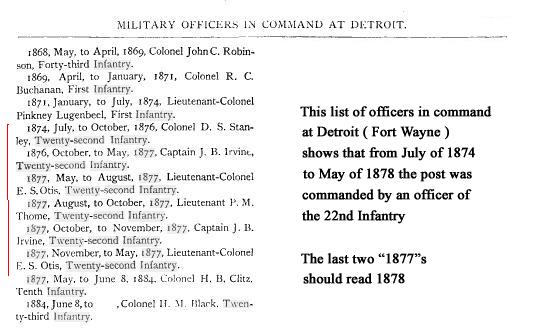
(Ed., The above list shows officers
from the 22nd Infantry being officially in command at Fort Wayne.
Note that officers could be away from that command, as in : on
campaign with their troops,
on leave, etc., and still be officially in command at Ft Wayne.)
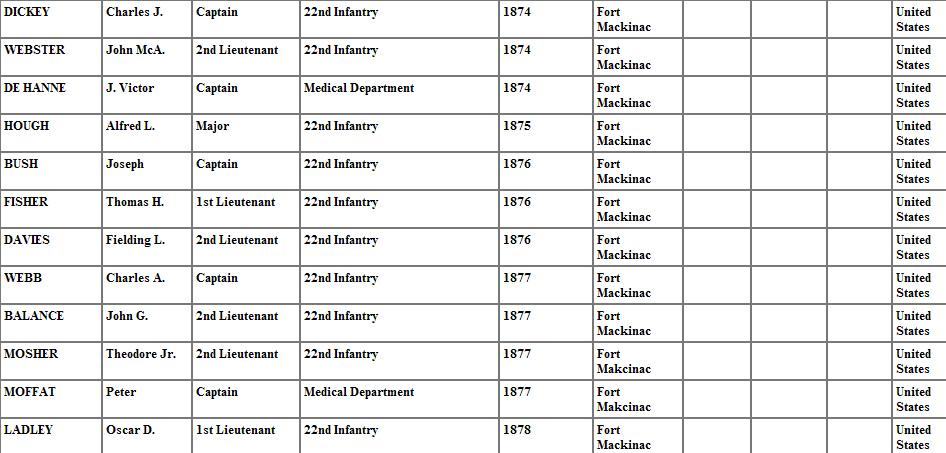
The above chart shows 22nd Infantry
officers who were stationed
at Fort Mackinac, Michigan, from 1874 to 1878. (John G.
Ballance's name is mis-spelled.)
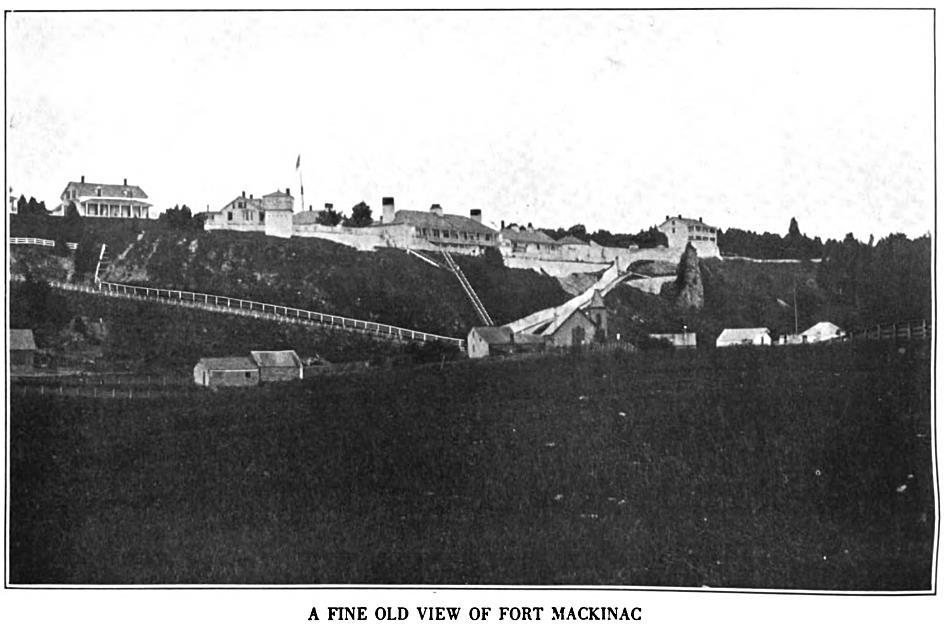
Photo from:
Historic Mackinac by Edwin O. Wood
NEW YORK THE MACMILLAN COMPANY 1918
**********************
In July, 1876, the now famed Custer Massacre
was the cause of again sending the 22nd Infantry into the field,
and on July 11,
less Company A, the same command left Fort Wayne to join General
Terry at the mouth of the Rosebud River in Montana.
Companies E, F, G, H, I and K, under Lieut.-Colonel E. S. Otis,
represented the regiment and were conveyed by the steamboat
Carroll
to General Terry's mobilization point. Hostile Indians were
encountered on several occasions, notably at the mouth of the
Powder River,
where a formidable force was encountered and only driven off
after a stubborn fight.
On July 29, when the boat
was passing the mouth of the Powder River, the Indians in large
number from the right bank
of the Yellowstone made a vigorous attack upon it. The troops
responded promptly, and the boat was landed
and two or three Companies sent on shore. The fight lasted some
time, engaged in by the troops on the boat as well
as those on shore, until the Indians were driven back into the
hills, with what loss we never knew.
Their camp was taken possession of and burned, a few firearms and
other trophies being found and taken on the boat.
There were two or three soldiers slightly wounded.
On August 1, the battalion arrived at General Terry's camp, where
it remained until the 7th. The next day it marched
with General Terry's command up the Rosebud. The valley of the
lower Rosebud is very rough and the marches
were short and difficult. In the forenoon of the 10th there was
great excitement, as a heavy dust was seen
rising some two or three miles in our front and horsemen riding
around. Reports went down the line
that we were approaching the hostiles, and an engagement was
expected within a few minutes........ 1
( Ed., the horsemen turned out to be Buffalo Bill Cody and his scouts.)
On the 10th William F. Cody, familiarly known
as "Buffalo Bill", was encountered with his detachment
of Indian Scouts.
Cody informed General Terry that he might expect to meet a force
under Crook within a few hours, and, in fact,
a junction of the two columns was effected that night.

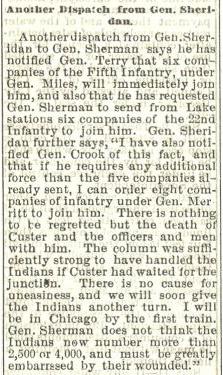
An article from the Deseret Evening
News, of Salt Lake City, Utah, published on July 10, 1876,
noting that six companies of the 22nd Infantry
had been requested by General Sheridan to join General Terry's
forces,
already on campaign in the Little Big Horn area.
The campaign which followed provided little in
the way of combat. Constant marching, scouting and bivouacking
under disheartening conditions failed to reveal a fighting force
of the Indians, and on August 31 the entire command
was concentrated at the mouth of Glendive Creek and the campaign
was discontinued.
Accompanied by two units of the 17th Infantry, the 22nd remained
in Montana most of the winter, their duties being limited
to providing escorts for wagon trains to the camp near Fort
Keogh. At Spring Creek, at three o'clock on the morning
of October 11, 1876, one of these escorts, composed of Companies
G, H and K, 22nd Infantry, and Company C of the 17th,
was attacked by Indians in force. The attack was repulsed, but
the Indians succeeded in stampeding many of the expedition's
animals,
mostly mules, and thereby so crippled the transportation that the
command was compelled to return to Glendive.
On October 14, Colonel Otis again set out with the same units,
reinforced by Company G, 17th Infantry. The Indians again
attacked in force
on the morning of the 15th, but the train was well protected and
the attacking force accomplished nothing. Several soldiers were
wounded,
but none killed. Private Donahue, Company G, who was wounded July
29, was again wounded in this fight. An amusing communication
was received by Colonel Otis the following day, written by a
half-breed said to have been well known to the troops. The letter
is quoted in full:
"YELLOWSTONE.
"I want to know what you are doing travelling on this road.
You scare all the buffalo away. I want to hunt on the place.
I want you to turn back from here. If you don't I'll fight you
again. I want you to leave what you have got here, and turn back
from here.
I am your friend,
SITTING BULL.
"I mean all the rations you have got and some powder. Wish
you would write as soon as you can."
Colonel Otis replied that he would be pleased
to accommodate Sitting Bull's force with a fight, but that he had
to take his train on to Tongue River.
On further consideration the Indians decided not to press
matters, and no further action took place. Colonel Otis, in his
official report
of the fight of October 15, highly commends the officers and men
of his command for their untiring and efficient performance of
duty.
In December, 1876, Companies E and F, 22nd
Infantry, formed part of General Miles' expedition against the
Indians under Sitting Bull
and Crazy Horse in the Big Horn Mountains. This expedition
campaigned under the greatest hardships, due to the excessively
cold weather
and heavy snowfalls. The two companies returned to Tongue River
on January 18, 1877. Two months later Companies E and F were
joined
by Companies G and H at that station. During the campaigns of
1876 some few casualties occurred in the regiment, notably the
death
from wounds of Private Bernard McCann, Company F; Corporal (later
Sergeant) Julius Schou, Company I, 22nd Infantry, was awarded
a Medal of Honor for distinguished conduct during the campaign of
1876 against the Sioux Indians, in carrying a dispatch to Fort
Buford,
Dakota, and safely delivering it to the Post Commander.
Julius Schou Photo by Nathan Zimbrich |
Medal of Honor Citation: SCHOU, JULIUS Julius Schou was born July 17,
1849 at Copenhagen, Denmark. Julius Schou is buried in Section 17 at Arlington Cemetery. |
|
( Ed., Corporal Julius Schou's Medal of Honor
Citation states that he was awarded the Medal for actions in
1870.
However, the Regimental history indicates it was for the
campaigns of 1876. Schou did not actually receive his Medal until
1884.
Later volumes of the Army Register corrected the date to read
1876, however, several official accounts of the Medal of Honor
citation
still include this 1870 date.)
The following article from The Spokesman-Review
newspaper from Spokane, Washington, edition of March 18, 1896,
gives the story of Julius Schou's Medal of Honor action:
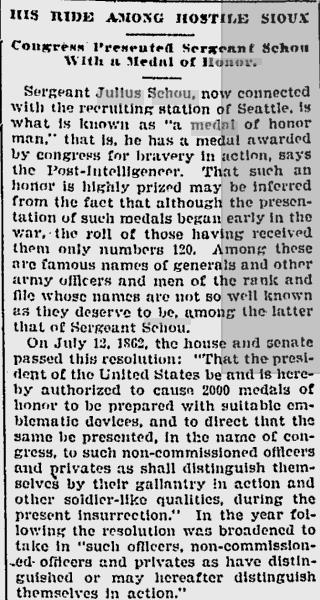
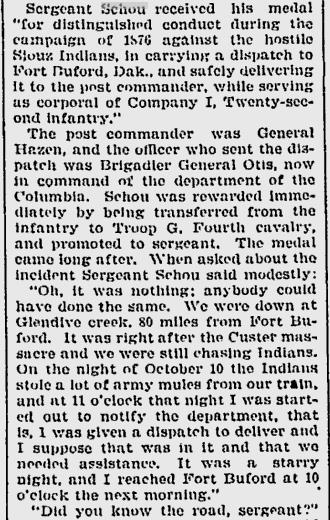
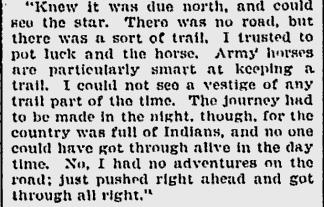
**********************
The Battle of Wolf Mountain
Ed., By the end of August 1876
the huge gathering of Sioux and Cheyenne who had defeated Custer
at the Battle of the Little Bighorn
had mostly broken up into individual tribes and factions, and the
Army discontinued General Terry's campaign against them.
As the Indians scattered into semi-permanent camps to hold up
against the harsh Dakota winter, Terry's column was also
ordered to do the same. Colonel Nelson Miles, in command of the
5th Infantry, was directed to build a post near the junction
of the Tongue and Yellowstone rivers where it was expected he and
his command would wait out the winter months.
On November 8, 1878 this post would be officially named Fort
Keogh.
Miles welcomed the opportunity
to be independent from Terry and believed his smaller command
could be effective against
the nomadic hostile tribes. In addition to his twelve companies
of the 5th Infantry, Miles secured the transfer to his command
of six companies of the 22nd Infantry and two companies of the
17th Infantry. During October and November of 1876
Miles 's troops continually harrassed Sitting Bull's band and
after three sizeable engagements with that band, had managed
to inflict enough losses in food, shelter and supplies upon them
as to render them ineffective as a fighting force.
|
Private, 22nd Infantry,
1876-77 Dressed for Nelson Miles' winter campaign Illustration by Richard Hook From the book: US Infantry in the Indian Wars 1865-91 By Ron Field, Osprey Publishing Ltd. 2007 |
By December the largest band of
hostiles who refused to return to the reservations was led by
Crazy Horse,
encamped along the Tongue River Valley. The winter had come early
and was extremely brutal. Game was scarce and food supplies
were dwindling, and, as survivors of engagements with the Army
and other tribes joined Crazy Horse, he became reluctantly
convinced that it was necessary to negotiate some kind of peace
terms with his enemies. A delegation was sent to ask Miles for
peace terms.
As five Sioux
headmen from Crazy Horse's village advanced on the post to
ascertain chances for a peaceful settlement
of the conflict, they were suddenly attacked by the Army's Crow
Indian scouts. All the Sioux were killed before soldiers
rushing from the garrison could save them. The episode ruined any
prospect for a peaceful outcome to the war. 2
Ed., As revenge for the
killings, Crazy Horse sent a party of 100 warriors to attack
Miles' post as a decoy, in an attempt to draw the soldiers out,
with the idea of leading them into a trap which could be set to
inflict upon them a high number of casualties.
Although Miles had not
planned to conduct another winter campaign after defeating
Sitting Bull, within days of the killings
the decoy party's retaliatory strikes demonstrated to Miles that
a campaign would have to be organized and sent into the field
that winter.
On December 18 warriors attacked government mail contractors
within miles of the post and made off with the mail and
several government animals, forcing cancellation of mail service
to the post. On December 20, 1876, the commander wired
department headquarters in St. Paul, Minnesota, to declare his
intentions. On December 26 the decoy party struck again
less than a mile from the post, stealing nearly two hundred fifty
head of cattle from the post's beef contractor and driving them
into the interior of the Tongue River Valley. Miles dispatched E
and F Company, Twenty-second Infantry, and K Company,
Fifth Infantry, under the command of Captain Charles Dickey to
pick up the Indians' trail while he finalized preparations for
his campaign.
On December 28, 1876,
Colonel Miles led the balance of his strike force away from
Cantonment Tongue River. Joining the three units
already in the field were companies A, C, D, and E, Fifth
Infantry; a detachment of forty mounted infantrymen drawn from
several companies;
five white and three Indian scouts; and the campaign's supply
train, 436 men in all. Miles also brought along two pieces of
field artillery-
a twelve-pound Napoleon cannon and a Rodman gun, a three-inch
ordinance rifle that he hid under canvas-covered wagon bows.
As the column began its
march, it was clear to all that nature would prove as much an
adversary as the warriors. Temperatures dropped
to thirty degrees below zero, and ten inches of fresh snow
greeted the troops that morning. Clad in overcoats made of
buffalo robes-which were worn
over numerous other layers of clothing-the company looked,
according to their commanding officer, more like arctic explorers
than soldiers.
With his command united,
Miles followed the Indians' trail southwest through the Tongue
River Valley for the next several days.
Fighting harsh winds, bitter subzero temperatures, deep snows,
and frequent river crossings, the strike force advanced as fast
as possible
up the river. It was a grueling march. At the more than one
hundred river crossings, wagons often plunged through the ice,
taking men and animals into the freezing water with them. 3
Ed., Crazy Horse's plan to
decoy the soldiers into an ambush quickly fell apart, as a
scouting party under Luther "Yellowstone" Kelly
captured
nine prisoners who were trying to make their way to the Indian
camp. This event caused the decoy party to attack the soldiers
prematurely,
which allowed Miles to position his command to repel any attack
by the larger body of hostiles. The terrain Miles had chosen for
that night's
bivouac along the Tongue River favored his defensive strategy. At
this point the landscape consisted of rolling hills ending in
open plains
at the river. A conical shaped butte on his side of the river
could be used by Miles to station a company of troops who would
have
a high ground advantage on the whole battlefield. The river here
was frozen solid and thus was not an obstacle as it could be
easily crossed.
As Crazy Horse and his 400 warriors approached, Miles sent A
Company 5th Infantry, under Captain James S. Casey, to join E and
K Companies
5th Infantry at the base of the butte. ( From 1895 to 1897 James
S. Casey would be the Colonel in command of the 22nd Infantry.)
On the other side of the butte, at the river's edge were Captain
Charles Dickey with E Company 22nd Infantry and
Lieutenant Cornelius Cusick with F Company 22nd Infantry, ready
to repel any direct attack made by the Indians across the river.
Company K 5th Infantry was sent across the river to slow down any
direct charge made by the hostiles.
|
First Lieutenant Cornelius
Charles Cusick commanded Company F 22nd Infantry He served as a 2nd LT and then
1st LT in the 132nd New York Infantry during the When the 31st Infantry was
consolidated into the 22nd Infantry in May 1869, He was promoted to 1st
Lieutenant on August 5, 1872, and Captain on January 1,
1888. |
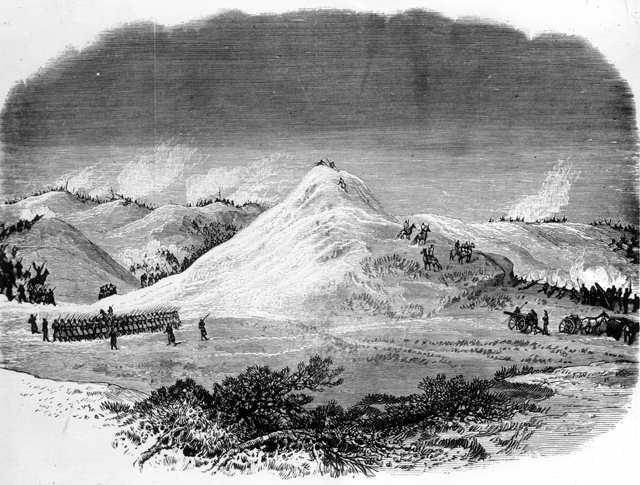
Although not drawn to scale, this illustration of the Battle of Wolf Mountain gets most of the details correct.
Illustration from the May 5, 1877 edition of Frank Leslie's Illustrated Newspaper
In tactics usually not
associated with them, a great many of Crazy Horse's men
dismounted their horses and prepared to engage the soldiers on
foot.
At about 7 am January 8, 1877, the warriors began the attack. For
several hours the Indians repeatedly attacked Company K, but were
driven back
by rifle and artillery fire. Half the Indian force, consisting of
Cheyenne under Medicine Bear, succeeded in outflanking the
soldiers
and took positions in a series of three smaller ridges near the
butte. Captain Casey took his company in a skirmish line
and advanced upon the ridges. Company D 5th Infantry was sent to
join Captain Casey. As they fought their way up the ridges,
Company C 5th Infantry reinforced them and the three companies
pressed the attack.
When their medicine man Big Crow was cut down by soldiers'
bullets, many of the Cheyenne warriors took it as a sign of
disaster
and left the fight, leaving the Lakotas under Crazy Horse to bear
the burden of the rest of the battle. As the soldiers continued
pushing the Indians back across the ridges, Miles shifted his two
cannon upon the hostiles and this, together with the rifle fire
from the infantry
forced Crazy Horse's warriors into a covering retreat through
heavy falling snow. The cannon fire was especially effective, not
only
in a direct-fire mode, but also in high trajectory plunging-fire
into the ravines between the hills and mountains.
The two artillery pieces were handled by Lieutenant J.W. Pope of
the 5th Infantry and Lieutenant E.W. Casey of the 22nd Infantry.
After five hours of fighting, Miles' command suffered two killed
and nine wounded. One of the wounded was Private Bernard McCann,
of Company F 22nd Infantry. McCann would die of his wounds on the
return march, and for his actions during the battle
would be awarded the Medal of Honor.
The next morning Miles led
six companies across the battleground looking for enemy bodies,
but found none. Several dead horses were found,
and numerous pools of blood were also found, along with
indications that the Indian wounded had been dragged away by
their fellow warriors.
It is believed that seven Indians were killed in the fight.
However, the loss of supplies and ammunition, coupled with the
realization
that they were not safe from the soldiers even in the worst of
winter, was a demoralizing blow to the Sioux and Cheyenne.
Over the next few months huge numbers of Indians surrendered at
different agencies all across the territory.
Crazy Horse was never again able to take to the field against the
Army, and within a few months would surrender himself
to the foe against which he struggled for so long.
|
Medal of Honor Citation: McCANN, BERNARD Bernard McCann was awarded the
Medal of Honor PVT McCann's grave is located
in Custer National Cemetery, |
Medal of Honor |
On April 30, 1877, an expedition was organized
under General Miles to attack a renegade band of Indians, chiefly
Minneconjous,
led by Lame Deer. General Miles' command was composed of
Companies E, F, G, and H, 22nd Infantry, two companies of the 5th
Infantry,
and four troops of the 2nd Cavalry. The train was left on the
Tongue River, about 60 miles from the starting point, under guard
of
Company G, 22nd Infantry, and Companies E and H of the 5th.
Companies E, F, and H, 22nd Infantry, with the 2nd Cavalry
detachment,
moved up the Rosebud, and on May 7 attacked the Indians near the
mouth of Muddy Creek. The herd of 450 Indian ponies was taken
in a surprise attack by a detachment of scouts under Lieutenant
Casey. A dash by the cavalry convinced Lame Deer and Iron Star
that they must surrender in order to save themselves, but they
met with great difficulty in convincing their followers of this
necessity.
The resultant delay caused the death of both these chiefs and
fourteen of their men.
The 450 ponies provided mounts for the entire battalion of the
22nd, and the following morning, after completing the destruction
of the Indian camp,
the command started back to the Tongue River. The Indians made
one effort to recapture their ponies, but were quickly driven off
by the troops.
Following this action Company E returned to camp, Companies F, G
and H delaying their return until May 31 in order to scout in the
direction
of the Little Big Horn. May 26 Companies I and K left Glendive to
complete the consolidation of the battalion under Colonel Hough.
Almost immediately, however, Colonel Hough was detached and
ordered to Fort Mackinac, and the battalion of the 22nd Infantry
came under the command of Colonel Lazelle of the First Infantry.
Under this officer a long scout was made into the Black Hills.
The trail of Lame Deer's Indians was picked up and followed for
several days, but no action of any importance took place.
Arriving near the Indian camp at Sentinel Butts, the 22nd
Infantry was relieved, and under command of Brevet Major C. J.
Dickey,
it proceeded by marching to Fort Abraham Lincoln.
Ed., The Battle of Wolf Mountain, and then
finally, the Lame Deer Fight wrote an end to the great Sioux War
of 1876-1877.
The Battle of the Little Bighorn was the apex of the Sioux and
Cheyenne alliance, and their greatest victory. The alliance fell
apart
after that battle, and thereafter the Indians were constantly on
the defensive. Nelson Miles' winter campaign against the Sioux
and their allies cost the Indians dearly in un-replenishable
supplies and food, and denied them any respite during the
especially
harsh winter of 1876-77. Demoralized and defeated, nearly all the
tribes returned to the various Indian agencies across the
territory.
Crazy Horse surrendered in May of 1877, Sitting Bull led his
faction into Canada that same month, and the war was over.
When the command reached this post (Fort
Abraham Lincoln) news was received that the companies would
proceed to their home stations
from Duluth by boat, but the railroad riots in Chicago drew the
command to that city, where Colonel Hough again took command.
A few days later Companies A, B, C, D, E, F, G, H, I and K were
ordered to Wilkes-Barre, Pennsylvania, in connection with mining
riots.
In October, 1877, the companies all returned to their proper
stations. It is of interest to note that in the preceding year
the greater part of the command had marched a little over three
thousand miles.
The Chicago Railroad Riots
Ed., The 22nd Infantry had arrived in Chicago
July 25 to assist authorities in maintaining order during the
Railroad Strike of 1877.
A mob of some 25,000 unemployed and angry workers were milling
about the city and there was worry that they may organize into
something
dangerous to life and property. The Secretary of War, George W.
McCrary anticipated that federal intervention would be necessary,
and ordered Colonel Richard C. Drum to send federal troops to
Chicago. Drum was the adjutant to General Sheridan, who was the
commander
of the Department of the Interior's Division of the Missouri, and
in Sheridan's absence Drum was de facto commander himself.
It was expected that the federal troops would be placed under
command of the governor or the mayor, to be used as they saw fit.
Although no major strikes
or riots had yet occurred in the area, and without presidential
action, McCrary directed Drum
to build up an antiriot force from six companies of the 22d
Infantry, whose 226 officers and men were at Detroit on their way
to new assignments.
Drum immediately summoned two companies into Chicago, but kept
the remaining four outside the city in reserve.
During the next two days McCrary shifted several more companies
composed of 218 officers and men of the 9th Infantry, from Omaha,
Nebraska, to the Rock Island Arsenal 150 miles southwest of
Chicago. The 9th Infantry was to provide support for the 22d,
but only if requested to do so by the Chicago mayor through the
Illinois governor or by the governor himself.
Thus far, no such requests had been received from either Mayor
Heath or Governor Shelby M. Cullom. 4
Ed., A further five companies of the 4th
Infantry and four companies of the 5th Cavalry were also sent to
Chicago.
President Rutherford B. Hayes was not consulted on the move of
Federal Troops to be used in what he considered
a job for a state government to handle, and he ordered that all
Federal Troops be directed to guard and preserve
the integrity of Federal Buildings and property only. As a
result, the federal troops took no direct part in handling any
disturbances caused by the mobs of workers; all direct action
taken against such was carried out by the police and the Illinois
militia.
However, the presence of so many federal troops around the city
was a factor of intimidation which was credited in large part
with keeping the violence which did occur to a minimum.
|
Left: Article published in the New York Times July 27, 1877 Although the President was not
consulted about the As can be seen in the article,
two Companies of the General Drum ordered the trains
bringing the troops to the city Article copyright © The New York Times |
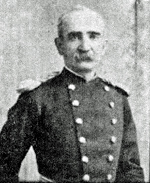
Captain Charles J. Dickey
Photo from the MHI
Ed. : The following document, General Court
Martial Orders Number 69, of 1877 is illustrative of the harsh
life and existence
of the Infantry Soldier during the long years following the Civil
War. CPT Charles Dickey was court-martialled for being
"drunk on duty" in Chicago 25 and 26 July 1877. CPT
Dickey had been on campaign in the Indian Wars for eight years
with the 22nd Infantry, and had been breveted to the rank of
Major. He was commended for his actions at the Battle of
Wolf Mountain in January of 1877, and had participated in the
Lame Deer Fight of May 1877. Less than two months after
that fight with hostile forces, he and his command were sent to
an American city, where it was supposed they would be
utilized to confront and possibly fight with American citizens.
It is of interest to note that the railroad strikes and riots of
1877,
which began in Pennsylvania and spread to other cities, were the
first time that federal troops were utilized to put down
civil disorders in the States. One can only speculate how the
regular Soldiers of the US Army felt about such duty.
General Court Martial Orders No. 69, October 29, 1877 |
The court martial of Captain
Charles J. Dickey, Charles J. Dickey was born in
Pennsylvania and was |
The Regimental histories written
in 1904 and 1922 do not have any entries for the year 1878.
From October 1877 to approximately April 1879 the 22nd Infantry
carried out routine
garrison duties at their posts in Michigan and the eastern United
States. This period of
a little over a year and a half was the only sustained break in
the Regiment's duty on the
western frontier during the years 1866-1898.
From November 1877 to April 1879
there is only one entry in the monthly Returns of the
22nd Infantry under the heading of Record of Events. That entry
occurred in October 1878
and recorded the movement of the Regimental Headquarters and Band
to Fort Porter, New York.
Colonel David S. Stanley commanding the 22nd Infantry, His
Adjutant 1st Lieutenant Hiram C. Ketchum,
Companies B and C and the Regimental Band would remain at Fort
Porter until April 1879 when the 22nd Infantry
was once again deployed to the western frontier.
During the years 1874 to 1878
the following losses were incurred by the 22nd Infantry.
Places of birth are listed when known.
KIA = Killed In Action
DOW = Died Of Wounds
DOD = Died Of Disease
( A catch-all phrase used in the 19th Century to denote any
non-battle death)
Company B
William A. Keogh.....02/25/1874
- Private - DOD - Rhode Island - Died of inflammation of the
lungs
Edward Kennedy.....09/19/1877 - Private - DOD - Waterford,
Ireland - Died of gunshot wound self inflicted
Company D
Timothy Driscoll.....10/30/1875 - Private - DOD - Cork, Ireland - Drowned
Company F
Bernard McCann.....01/12/1877 - Private - DOW - Ireland - Died of wounds received in Battle of Wolf Mountain awarded Medal of Honor
Company G
James A. Tomkiel.....08/19/1874
- Musician - DOD - Island of Corfu - Drowned
Henry Manuel.....05/30/1875 - Private - DOD - Dorset, England -
Died of aneurism at Fort Brady, Michigan
George Bowen.....09/29/1875 - Private - DOD - Middleport, New
York - Suicide
Band
Adolf Bergmann.....05/08/1875 - Private - DOD - Baden, Germany - Drowned
**********************
Much of the above text was taken from the Regimental History published in 1922, except:
1 From the 1904 Regimental History
2 From Battles and
Skirmishes of the Great Sioux War, 1876-1877 The
Military View
Compiled, edited and annotated by Jerome A. Greene,
Published by the University of Oklahoma Press 1993
3 From the article Nelson A.
Miles, Crazy Horse, and the Battle of Wolf Mountains by
Jeffrey V. Pearson
printed in Montana The Magazine of Western History, 2001
4 The Role of Federal Military
Forces in Domestic Disorders, 1877-1945 By Clayton David
Laurie,
Ronald H. Cole, Published by Center of Military History, U.S.
Army, 1997
Additional material added by the website editor
Additional information taken from:
Returns from Regular Army Infantry
Regiments, June 1821–December 1916. NARA
microfilm publication M665
National Archives and Records Administration, Washington, D.C.
Home | Photos | Battles & History | Current |
Rosters & Reports | Medal of Honor | Killed
in Action |
Personnel Locator | Commanders | Station
List | Campaigns |
Honors | Insignia & Memorabilia | 4-42
Artillery | Taps |
What's New | Editorial | Links |